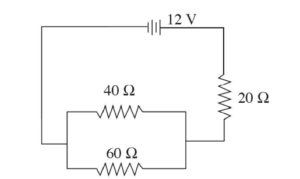Question

The circuit shown is built and the voltage source supplies voltage for 15 minutes before the battery is completely drained. Assume the voltage supplied by the battery is constant at 12 V until the battery is drained, after which the battery supplies o V.
(a) What is the equivalent resistance of the circuit?
(b) Two students are discussing the apparatus. Student 1 says, “If the 20 n resistor were not present, the overall resistance of the circuit would have been lower and the battery would have lasted longer.” Student 2 says, “If the 20 n resistor were not present, I think the power output would have been higher and the battery would have drained faster.”
(i) Use equations to show whether the overall resistance would have been lower without the 20Ω resistor present.
(ii) Use equations to determine whether the overall power output would have been higher.
(iii) Which student is correct about the battery life?
(c) The 20 Ω resistor is replaced with a capacitor.
(i) As soon as the circuit is connected, explain without using equations how the current drawn out of the battery compares between the original circuit and the circuit with the capacitor.
(ii) After the capacitor has been connected for a long time, but before the battery is completely drained, how does the current drawn out of the battery compare between the original circuit and the circuit with the capacitor?
▶️Answer/Explanation
Ans:
(a) The resistors in parallel are combined first.
Req-1 = 40-1 + 60 -1
Req = 40
The total equivalent resistance is then Rtotal = 24 + 20 = 44 Ω.
(b) (i) Without the resistor, there would only be the parallel resistor combination.
R-1 total = 40-1 + 60 -1
R total = 40 Ω.
(ii) P =IV= \(\left ( \frac{V}{R} \right )V,\) so a higher resistance results in a lower power output for the same battecy.
(iii) A lower power output means that it will take more time for the energy to be used up, so student 1 is correct.
(c) (i) As soon as the circuit is connected with the capacitor, the capacitor acts as if it had no resistance. This is exactly like
(b, i). The lower resistance would cause a greater current to be drawn from the battecy.
(ii) After the capacitor is fully charged, no more current can flow in the branch of the circuit with the capacitor. The capacitor is in series with the battecy, so there will be no
current drawn from the battecy.
